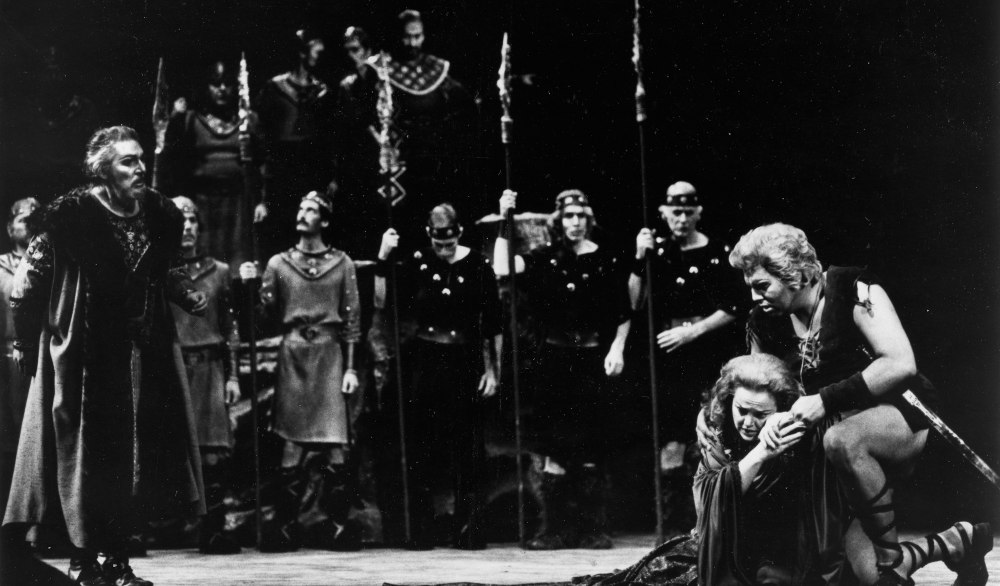
After sitting through 4-5 hours of Tristan Und Isolde under the partially exposed roof of the Santa Fe Opera House, I began to see the sense in Richard Wagner’s stormy and violent story of Irish princesses and Cornish kings. The New Mexican monsoon season had passed, the evening was clear and crisp, and the bars and restrooms were nearby. While ruined castles with secret doors and staircases loomed on the stage, our seats also provided a restful side-view of a dimming sunset and blinking star or two.
While focused on the Santa Fe stage in the cool night air, I was reminded of Glynn Ross, Seattle Opera’s founding director in the 1960s, and his dream of a “Festival in the Forest.” The merging outdoor-indoor Grand Opera idea in Seattle came within an inch of occurring in Federal Way. Like Santa Fe’s famous brick-colored hillside home, Ross described a Pacific Northwest entertainment site where the audience gathered in a sylvan setting.

Glynn Ross also eyed his “Festival in the Forest” in hard economic terms. First, he assumed that most vacationers were relatively affluent and had money available to find and reach innovative entertainment. In the case of Santa Fe, the founders and most attendees were and are well-off. That opera experience is high on the list of “to do” events in New Mexico.
Although audience attire today at the Santa Fe Opera House demonstrates whatever is comfortable, in an earlier era most attendees dressed to the nines, not unlike New Yorkers at the Metropolitan Opera.
Ross grew up in a Norwegian farming environment. After his father’s death he studied theater in Boston, then served in the U.S. Army. In 1948, he joined the San Francisco Opera as stage director. During this period, he staged operas in the Bay Area and at the famous Teatro di San Carlo in Naples, Italy.
In 1964, Ross accepted the position of director of Seattle Opera. That Pacific Northwest city was still basking in international attention brought by 1962’s World’s Fair, Century 21. The excitement of that time encouraged Seattle to create its first home-grown opera company. The relative success of local opera convinced Ross that more musical opportunities were at hand. The “Festival in the Forest” rose from that excitement, abetted by the dynamic personality of Ross.
A few local nay-sayers to Ross’s dream voiced concern about competing with local established musical and theater events if another “Grand Event” emerged. Support for Ross’s “Festival” appeared in the form of substantial business figures who listened closely to Ross’s pitch at private clubs, fraternal organizations, churches, and civic groups. One supporter was Seattle developer Jim Douglas who took the unusual step of asking forest products giant Weyerhaeuser to pledge 30 acres of its Federal Way campus for Ross’s project.
Weyerhaeuser was the largest timber marketer in the world, with a product catalog that included raw timber to structural supplies. Its new 500-acre site in Federal Way could include ample acreage for recreation and entertainment.
However, the economy was changing, and Weyerhaeuser reorganized as a real-estate investment trust (REIT), focusing on its real estate holdings and profitable subsidiaries. Glynn Ross’ “Festival” hopes evaporated and he was sent packing at the Opera. Glynn Ross died of a stroke on July 21, 2005
The Weyerhaeuser King County Aquatics Center today rests on the original “Festival in the Forest” site. Other local “outdoor” entertainments include the Gorge amphitheater, the White River Amphitheater, MaryHill winery, plays sponsored by the Mountaineers in several forest clearings, and musical performances on the Olympic Peninsula, to name only a few.
Santa Fe Opera is a rare institution, supported by a deep-pockets board and guaranteed influx of tourists to the exotic sites of New Mexico. Those factors failed to materialize for Glynn Ross and his dream of music in a natural setting.
The magic of Santa Fe Opera mixed with Wagner’s grand dramas recalls those days when Seattle dreamed big, mixing art with natural grandeur.
Discover more from Post Alley
Subscribe to get the latest posts sent to your email.

Dreaming about the good old days is an agreeable pastime as long as you don’t idealize them. Glynn’s Festival-in-the-Forest was a terrible idea, and a comparison of the climatic and demographic data of Tacoma and Santa Fe confirms that. Yes, you can get monsoon’d at Santa Fe Opera, but if you do you’re probably only blocks from a very expensive hotel room to dry off in. And getting rained on at 55 degrees in a woodsy setting is incomparably more unpleasant than getting rained on in a high dry desert.
Those early productions of the indoor Ring, featuring German and English language productions, were probably what eventually cost Ross his job as general director of Seattle Opera. They were way over the head of the small company, and major Wagnerian singers are in short supply. Eventually, some members of the Opera Board, embarrassed by the overstretch of the incorrigible Ross, surprised his defenders by putting together a narrow coalition to toss Ross. The subsequent Ring productions, assembled by Speight Jenkins, were vastly better, but may have led to Jenkins’ departure as the board grew wary of the financial burdens. It’s likely that this great leap forward into Wagner’s massive four-part opera will not be repeated at Seattle Opera.